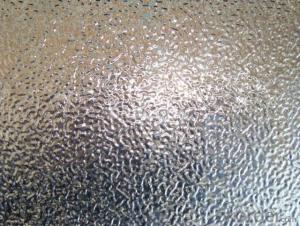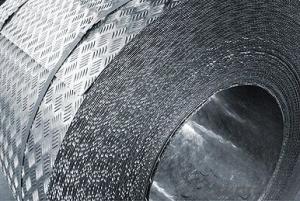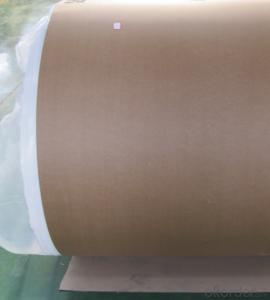Wide Aluminum Foil Sheets - Coated Aluminum Stucco Embossed Sheet/Coil
- Loading Port:
- Shanghai
- Payment Terms:
- TT OR LC
- Min Order Qty:
- 5 m.t
- Supply Capability:
- 5000 m.t/month
OKorder Service Pledge
Quality Product, Order Online Tracking, Timely Delivery
OKorder Financial Service
Credit Rating, Credit Services, Credit Purchasing
You Might Also Like
Specifications
coated aluminum stucco embossed sheet
1.flat, cleaned, bright no oil stain
2.using in bus, cars and shipping vessel as the
1.Features for coated aluminum stucco embossed sheet :
1) Alloy: AA1050, AA1060, AA1070, AA3003
2) Temper: H14, H16, H18, H24, H26, H28, H34, H36, H38
3) Thickness: 1.20mm - 5.00mm
4) Width: 1000 ~ 1250mm
5) Length of sheet: 1000mm ~ 4000mm
Packing for coated aluminum stucco embossed sheet
Covering with plastic film and brown paper and then packed with wooden
package, directly loading into container for transshipment.
Good elongation anticorrosion
Dimensions can be produced depend on customise

- Q: I have an aluminum block engine in my wakeboard boat which is built for the lakes, now i live on salt water and was wondering the effect saltwater would have on the engine block as water goes through to cool it.
- Listen to Randall. A heat exchanger is much cheaper than an engine block and heads.
- Q: What is the price range of aluminum sheets?
- The price range of aluminum sheets can vary depending on factors such as size, thickness, and quality. However, generally speaking, aluminum sheets can range in price from $1 to $5 per square foot.
- Q: What kind of welding rod should be used for aluminum plate, welding and welding?.
- Aluminum plate welding, if it does not take into account the deformation or the objective conditions of the gas, it is recommended to use AC aluminum arc welding machine welding, welding is also commonly used.If considering the deformation and welding method is more simple words, can be used in low temperature aluminum WE53 solid aluminum wire flame welding, the welding is more suitable for super thin aluminum sheet, the thinner the better welding.If it is in the plate, and no argon arc welding machine or manual, you can use the aluminum welding wire welding, aluminum welding wire welding using WEWELDING 555 aluminum electrode welding imports, there is a reference video you can go to see "the use of WE555 aluminum welding wire welding in the Aluminum Alloy"Do not understand, you can continue to ask
- Q: My understanding of the periodic table, the transitional metals all rust because the S shells are higher energy then the D shells. So all transitional metals have 2 valence electrons. (Roughly...some electrons like to move around and give different apparent charges.) So why does aluminum corrode if it doesn't have a 2+ charge?
- 'Rusting' commonly refers to the corrosion (oxidation) of iron so when talking about other metals, it is better to use the term 'corrosion' or 'oxidation'. Aluminum can corrode and the fact that it has a general oxidation number of +3 doesn't really matter. Many elements which have a charge that is different from +2 can oxidize. Alkali metals for instance (which have a charge of +1) can oxidize. Lithium can form lithium oxide (Li2O), sodium can form sodium oxide (Na2O) and so on. However, aluminum is known to be quite resistant to corrosion (oxidation) because it spontaneously forms a thin (solid) oxide layer at it's surface protecting it from further oxidation whereas iron, for an example, will easily lose that thin layer (it ''peels off easily'') exposing more iron to corrosion. So since Al has a +3 charge and O has a -2 charge, you'll need 2 atoms of Al and 3 atoms of O to make an electrically neutral compound. 2 atoms of Al = +6 charge 3 atoms of O = -6 charge Hence Al2O3 which is aluminum oxide. I hope it helps.
- Q: If I were to make an aluminum mold and cover it with a release agent, could I cast aluminum into it? Or would the two parts fuse together? I'm trying to find an alternative to sand casting.Thank you!
- This may be a little more difficult but offers better detail than sand casting. Lost wax casting Investment or ceramic shell You can make molds to form the wax but investment or ceramic shell are destroyed in the process
- Q: Is it feasible to recycle aluminum sheets and what factors contribute to its recyclability?
- <p>Yes, aluminum sheets can be recycled easily. Aluminum is one of the most recycled materials due to its lightweight, durability, and the energy efficiency of the recycling process. The recycling of aluminum requires only 5% of the energy needed to produce new aluminum from raw materials. Additionally, aluminum can be recycled indefinitely without losing its properties, making it an environmentally friendly choice. Proper sorting and collection systems are crucial for efficient recycling, and the demand for recycled aluminum is high in various industries, further facilitating its recycling process.</p>
- Q: Are aluminum sheets resistant to UV rays?
- Aluminum sheets, in general, exhibit resistance to UV rays. The reason lies in the formation of a protective oxide layer on aluminum's surface, which acts as a shield against UV radiation. By doing so, this oxide layer prevents the aluminum from deteriorating or corroding when exposed to sunlight. Nevertheless, it is worth mentioning that extended exposure to intense UV radiation may lead to gradual color fading or discoloration. To further fortify the UV resistance of aluminum sheets, one can apply protective coatings or paints, which add an extra layer of defense against UV rays.
- Q: Can aluminum sheets be used for boat building?
- Boat building can indeed incorporate aluminum sheets. The lightweight quality, durability, and resistance to corrosion make aluminum a favored material for constructing boats. Small recreational boats, larger yachts, and even commercial vessels commonly employ aluminum sheets in their construction. These sheets offer numerous benefits, including ease of manipulation, a remarkable strength-to-weight ratio, and minimal upkeep requirements. Furthermore, aluminum boats are esteemed for their exceptional buoyancy, stability, and fuel efficiency. All in all, utilizing aluminum sheets is a suitable and dependable choice for boat building.
- Q: How many square meters does the aluminum plate engrave?
- The price of aluminum sheet is calculated according to the price of aluminum ingot + processing fee (aluminum plate state), and the specific price is also different according to the size and size of aluminum sheet. If you have any questions, please ask, thank you.
- Q: It seemed in my experiment that aluminum wasn't reactive at all in the displacement reactions, except with copper sulfate. Is there a reason? or did I make a mistake? aluminum is more reactive than e.g silver nitrate, why didn't it react with it?
- Aluminium has a protective coating of Aluminium Oxide, this prevents many chemicals reaching the surface. This is because aluminium has a very strong affinity for oxygen and bonds to it with extremely strong bonds. It can be removed by dipping it carefully into a solution of Mercury (II) Chloride.
Send your message to us
Wide Aluminum Foil Sheets - Coated Aluminum Stucco Embossed Sheet/Coil
- Loading Port:
- Shanghai
- Payment Terms:
- TT OR LC
- Min Order Qty:
- 5 m.t
- Supply Capability:
- 5000 m.t/month
OKorder Service Pledge
Quality Product, Order Online Tracking, Timely Delivery
OKorder Financial Service
Credit Rating, Credit Services, Credit Purchasing
Similar products
Hot products
Hot Searches
Related keywords


























